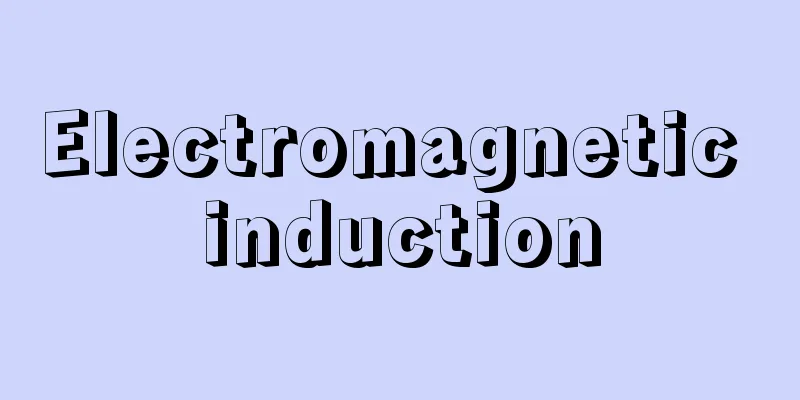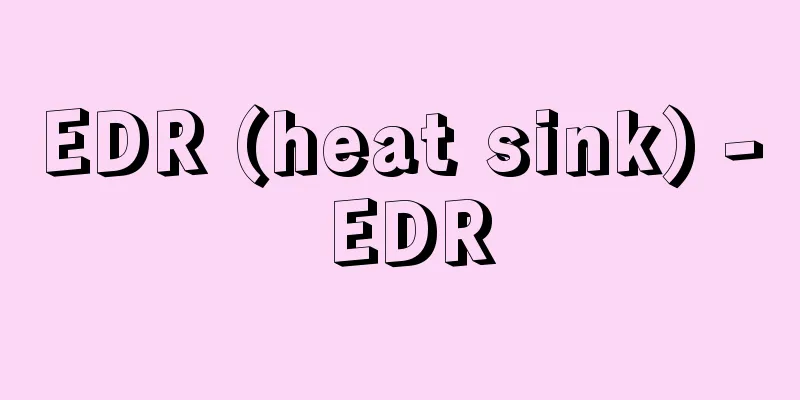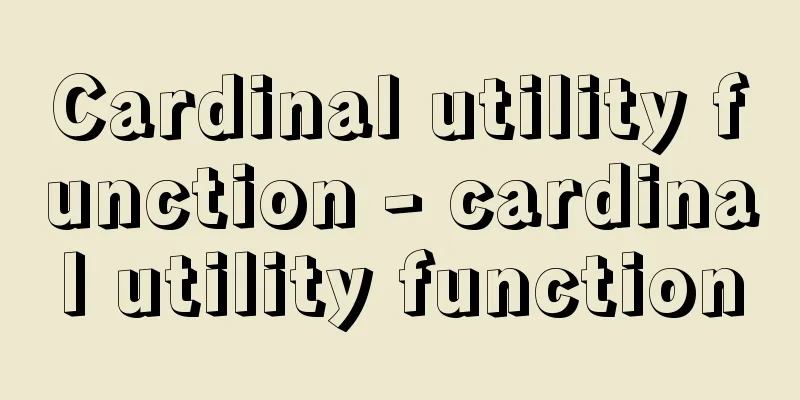Electromagnetic induction

|
A phenomenon in which an electromotive force is generated in a coil by changing the magnetic flux passing through the coil. There are six main methods for changing the amount of magnetic flux passing through a coil, i.e., generating an induced electromotive force ( ). (1) Moving a magnet, which is the source of the magnetic field, relative to the coil. (2) Moving the coil while keeping the magnet fixed. The magnetic flux passing through the coil is determined only by the relative positions of the magnet and the coil, so from this point of view, (1) and (2) are equivalent. Methods (3) and (4) are methods in which the magnet in (1) and (2) is replaced with an electromagnet (current circuit). Since magnets and current circuits are considered to be equivalent, (1) and (3), and (2) and (4) are essentially the same. (5) Deforming a coil in a magnetic field. (6) Keeping the coil and electromagnet fixed, changing only the current in the current circuit. Regardless of which of these methods is used to change the magnetic flux passing through the coil, the magnitude of the electromotive force generated in the coil is equal to the time rate of change of the magnetic flux passing through the coil. The electromotive force caused by electromagnetic induction is called induced electromotive force. One method to determine whether the positive side of the induced electromotive force appears at coil terminal a or b is based on Lenz's law. When coil terminals a and b are connected, a current flows due to the induced electromotive force. The magnetic field created by this current causes the magnetic flux that penetrates the coil to have a direction that opposes the initial magnetic flux change. Another method is to consider the direction of the circuit and the positive and negative directions of the magnetic flux that penetrate the circuit. In , if the direction of rotation of the circuit is defined as shown by the arrow, the positive and negative directions of the magnetic flux that penetrate the circuit are defined as shown in the figure. This is consistent with the so-called right-hand screw rule, where the direction of rotation of the circuit corresponds to the direction of rotation of a right-hand screw, and the positive direction of the magnetic flux corresponds to the direction of progress of a right-hand screw. When the magnetic flux increases in a positive direction, induced electromotive force occurs in the opposite direction to the direction of rotation of the circuit. In this sense, induced electromotive force is sometimes called back electromotive force. When an electric charge q moves in a magnetic field, the charge is subjected to a magnetic force from the magnetic field. The direction of the force is perpendicular to the plane determined by the magnetic field and the velocity. This type of force is generally called the Lorentz force. As shown in , when the magnetic field and the velocity are perpendicular, it corresponds to Fleming's right-hand rule. The law of electromagnetic induction from (1) to (5) in can be explained by the force that the electric charge receives from the magnetic field. However, the case of (6) cannot be explained by the Lorentz force. Therefore, the law of electromagnetic induction has meaning as a fundamental law. The law of electromagnetic induction is one of the four equations in Maxwell's equations that represent all the laws of electric fields and magnetic fields. The law of electromagnetic induction is deeply related to our daily lives. shows the principle of a transformer. When a current flows through the primary coil, the generated magnetic field is efficiently guided to the secondary coil by the iron core. When an alternating current flows through the primary coil, the magnetic flux also becomes alternating, and the time change of this magnetic flux generates an induced electromotive force in the secondary coil. This voltage is the voltage applied to the primary coil multiplied by the ratio of the number of turns in the secondary coil to the number of turns in the primary coil. shows the principle of a generator. There is a constant magnetic field within which a wire frame rotates. When the frame is parallel to the magnetic field, the magnetic flux penetrating the frame is zero. When it is perpendicular, the maximum magnetic flux penetrates. When the frame is rotated, the magnetic flux penetrating the frame changes, and an induced electromotive force is generated in the frame. This voltage is taken out. In electric circuits, resistors, capacitors, and coils are important linear circuit elements. When the current flowing through the coil changes, a back electromotive force is generated in the coil, which opposes the change in the current flowing through the coil. Therefore, a coil has the ability to make it difficult for AC current to pass through it inversely proportional to the AC frequency. In contrast, a capacitor makes it easy for AC current to pass through it in proportion to the AC frequency, and a resistor has a resistance to the passage of AC current that is unrelated to the AC frequency. [Shigeo Yamaguchi] [References] | | | flux| | | 's equations| |©Shogakukan "> Methods for generating induced electromotive force (Fig. A) ©Shogakukan "> Direction of induced electromotive force (Figure B) ©Shogakukan "> Electromagnetic induction and Lorentz force (Fig. C) ©Shogakukan "> Transformer principle diagram (Fig. D) ©Shogakukan "> Principle diagram of a generator (Figure E) Source: Shogakukan Encyclopedia Nipponica About Encyclopedia Nipponica Information | Legend |
|
コイルを貫く磁束が変化することにより、コイルに起電力が発生する現象。コイルを貫く磁束数を変化させる主な方法、すなわち誘導起電力を発生させる方法は六つある()。(1)コイルに対して磁界(磁場)の源である磁石を動かす方法。(2)磁石を固定しておきコイルを動かす方法。コイルを貫く磁束は、磁石とコイルの相対的位置関係だけで決まるので、この観点からみれば(1)、(2)は同等のものである。(3)、(4)の方法は(1)、(2)の磁石を電磁石(電流回路)で置き換えたものである。磁石と電流回路は同等であるとみなされるので、(1)と(3)、(2)と(4)は本質的に同じものである。(5)磁界の中でコイルを変形させる方法。(6)コイルおよび電磁石は固定しておき、電流回路の電流のみを変化させる方法。これらのどの方法によってコイルを貫く磁束を変化させても、コイルに生ずる起電力の大きさは、コイルを貫く磁束の時間変化率に等しい。電磁誘導による起電力を誘導起電力という。誘導起電力の正の側がコイル端子a、bのどちら側に現れるかを判断する方法の一つは、レンツの法則による方法である。コイル端子a、bを接続すると、誘導起電力による電流が流れる。この電流がつくる磁界によりコイルを貫く磁束は、初めの磁束変化を妨げる向きのものでなければならない。もう一つの方法は、回路の向きと、回路を貫く磁束の正負の向きを考える方法である。において、回路を回る向きを矢印のように定めた場合、この回路を貫く磁束の正負を図に示すように定める。これはいわゆる右ねじの法則と一致しており、回路を回る向きが右ねじの回転方向、磁束の正の向きは右ねじの進む向きに相当する。誘導起電力は、磁束が正の向きに増大するとき、回路を回る向きと逆向きに発生する。この意味で、誘導起電力を逆起電力ということもある。 磁界の中で電荷qが運動するとき、電荷は磁界から磁力を受ける。その向きは、磁界と速度とが定める平面に垂直な向きである。一般にこのような力をローレンツの力とよぶ。に示すように、磁界と速度が垂直な場合はフレミング右手の法則に相当している。の(1)から(5)までの電磁誘導の法則は、電荷が磁界から受ける力によって説明される。しかし、(6)の場合は、ローレンツの力から説明できない。それゆえ、電磁誘導の法則は原理的な法則として意味をもつのである。電磁誘導の法則は、電界・磁界のすべての法則を表すマクスウェルの方程式の四つの式の一つとなっている。 電磁誘導の法則は、われわれの生活とも関係が深い。は変圧器の原理図である。一次コイルに電流を流すと、発生した磁界は鉄芯(しん)によって効率よく二次コイルへ導かれる。一次コイルに交流電流を流せば磁束も交流となり、その時間変化によって二次コイルに誘導起電力を発生する。この電圧は、一次コイルに加えた電圧に、二次コイル巻数の一次コイル巻数に対する比を乗じたものになる。は発電機の原理図である。一定の磁界があり、その中で針金の枠が回転するようになっている。枠が磁界と平行になっているときは、この枠を貫く磁束はゼロである。垂直なときは、最大の磁束が貫く。枠を回転させると、枠を貫く磁束が変化し、枠に誘導起電力が発生する。この電圧を外部へ取り出す。電気回路において、抵抗、コンデンサー、コイルは線形回路素子として重要である。コイルに流れる電流が変化すると、コイルに逆起電力が発生し、コイルに流れる電流の変化を妨げる。それゆえ、コイルには、交流周波数に反比例して交流電流を通しにくくする働きがある。これに対してコンデンサーは交流周波数に比例して交流電流を通しやすく、抵抗は交流周波数と無関係な交流電流の通りにくさ(抵抗値)をもつ。 [山口重雄] [参照項目] | | | | | | | | |©Shogakukan"> 誘導起電力を発生させる方法〔図A〕 ©Shogakukan"> 誘導起電力の向き〔図B〕 ©Shogakukan"> 電磁誘導とローレンツの力〔図C〕 ©Shogakukan"> 変圧器の原理図〔図D〕 ©Shogakukan"> 発電機の原理図〔図E〕 出典 小学館 日本大百科全書(ニッポニカ)日本大百科全書(ニッポニカ)について 情報 | 凡例 |
<<: Record of training - Denshuuroku
Recommend
Two hundred and ten days - Nihyakutooka
One of the miscellaneous festivals in the calenda...
Neurosurgery - Nougeka (English spelling)
This is a medical specialty that deals with surgi...
Hydrocharitaceae
...The "tochi" in "tochikagami&quo...
Popolo d'Italia (English spelling)
An Italian political newspaper. It was founded in ...
Yi Hyo-seok (English spelling)
[Live] Yong Hee 1 (1907).2.23. Gangwon-do, Pyeongc...
Raclette
…(5) Swiss cuisine and cuisine of Benelux countri...
Chandler, AD
… [Diversification Strategy in the United States]...
Kilogram-force - 100 kilograms
The unit of force in the MKS gravitational system....
Hertz, CM (English spelling) HertzCM
…Ultrasound is a method of recording the movement...
Marshallian k - Marshallian k
The ratio of a country's money supply to its n...
Basic industry
…The first type is export industries, which engag...
Division of a plant - Kabuwake
This is a vegetative propagation method used for ...
Prologue
The word prologue comes from the word prologos, w...
Gaius Julius Caesar Octavianus
…Being favored by Caesar, who had no legitimate s...
Polynomial ring
Generalizing the idea of a polynomial in x with...









